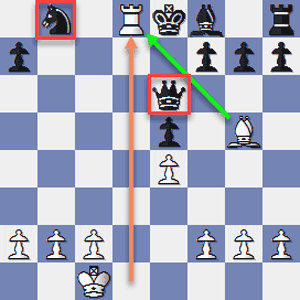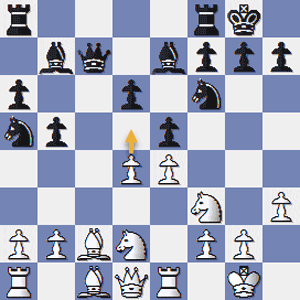Use Logical Chess Opening Strategy
There are a number of things to consider for chess opening strategy. Firstly rapid development of our pieces is crucial. Piece mobility is also critical. It is important to post your pieces to good squares in as few moves as possible to maximize their power. Any move that also frustrates your opponent from achieving the same ends is very worthwhile.
In the openings attention must be also be paid to the pawn structure. The pawns are a crucial part of the struggle for the center, which begins here. Center pawns must also be pushed on in order to develop the pieces.
Choose Openings Based on Pawn Structure
Chess Opening Strategy (Open Sicilian) The pawn structure in this opening results in a central majority for Black
It is important to recognize the significance of the pawn and the pivotal role that they play in chess. Acclaimed 18th Century chess player Philidor correctly described pawns as the soul of chess.
Pawn structure is central to chess opening strategy. Keep a sound pawn structure, shielding the King's stronghold from attack, battling for the center and allowing for quick development.
Fight For the Center
Chess Opening Strategy (English Opening, Botvinnik System) The struggle for the center is instrumental in determining the pattern and the outcome of the game
The central pawns and Bishop's pawns are pushed on. Knights and Bishops join the fight for the center which will continue into the middlegame. In the opening the pieces are provisionally developed. The main struggle takes place in the middlegame.
In the King's Pawn Openings and the Queen's Pawn Openings a direct claim for the center is made. In the Flank Openings (Irregular Openings) the center is initially surrendered only to be attacked from the sides.
Rapid Development is Crucial

Chess Opening Strategy: Morphy - Count Isoaurd (Paris, 1858); This game, dubbed A Night at the Opera is a famous miniature concluding with 17.Rd8#. White develops much faster than Black, and as a result, wins quickly in spite of being down a Knight and Queen
The Queen should also be tucked in safely for now, preferably on the second rank. She would be vulnerable to capture if she were sent to the heart of the battle early on.
At the very least your opponent will likely steal time from you by attacking her as he develops. A safe position not beyond the third rank is best for this important lady.
Get Your Pieces Mobile
Chess Opening Strategy (Danish Gambit) White uses this gambit to get mobile pieces quickly, look at the power of his Bishops
The best squares for Knights are towards the center. Bishops should be placed on the long diagonals or the next diagonal over. What you want is pieces to have command of as many squares as possible. They should exert their influence on the central squares. This will limit the space available to your opponent.
It is better for your pieces if your pawns win space. The pieces can then support each other while avoiding blocking one another. You can more easily achieve harmony between your pieces if you gain a space advantage.
The Peril of Lost Moves
Lost moves are usually fatal. Here after just three moves Black has already allowed White a massive lead in development
Any move made by either piece or pawn that does not lend itself to achieving these aims can be considered a lost move. Moving a piece from one location to another in more moves than necessary represents a lost move. As does moving pawns that do not need to be moved early on.
Dropping tempi due to lost moves has serious consequences. The ultimate price is always paid against an experienced opponent for these errors.
Hamper Your Opponent When You Can

Chess Opening Strategy: Boleslavsky - Bondarevsky (Tblisi, 1951) White will play 14.d5 limiting the light square Bishop which has just been moved to b7. The effect is so great that the Bishop immediately returns to c8 as he has no future on the long diagonal.
Whether you are playing against a beginner, an intermediate or an advanced player, you should approach the game in the same way.
Your opponent may or may not approach the game armed with sound strategy. No matter you should play your own game. As you know what you need to do, equally you know what you should try to prevent your opponent from doing.
Moving On
This is a skeletal set of principles of best practice. You will develop your own style with experience. You will put the meat on the bones. The advice given here is mainly for guidance. These ideas were developed by the world's best. They learned the hard way through trial and error.
You have begun to get to grips with best practice principles for your openings. All you need now are some reliable systems which you will now understand. Tell everyone about your best chess moves.






